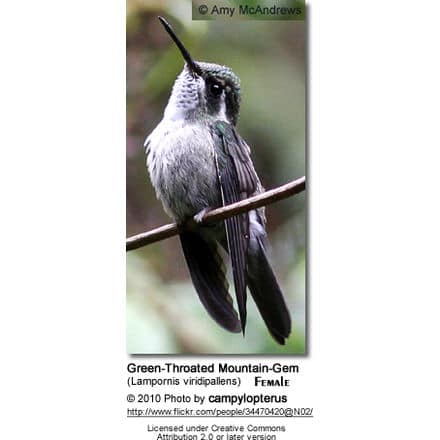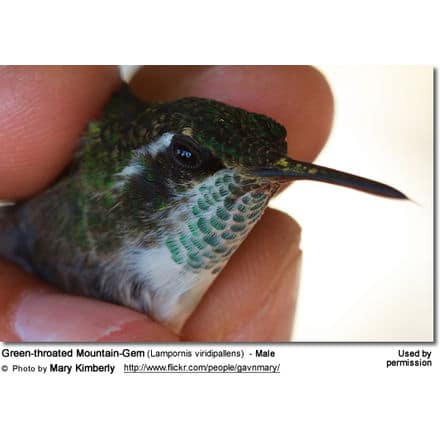Green-Throated Mountaingems
The Green-throated Mountaingems (Lampornis viridipallens) are fairly large hummingbirds found in Southern Mexico and Central America.
Distribution / Habitat
These non-migratory birds are resident in the mountains of Oaxaca and Chiapas in Southwestern Mexico south to the countries of Guatemala, El Salvador and Honduras.
They are found at elevations between 3,000 – 8,900 feet (~ 900 – 2,700 m), where they inhabit humid pine, pine-oak, cloud forests, and rainforests.
Subspecies and Ranges:
Some resources incorporate the below subspecies with the Green-breasted Mountaingem – Lampornis sybillae)
Green-throated Mountain-gem (Lampornis viridipallens or sybillae viridipallens – Bourcier and Mulsant, 1846) – Nominate form
Found in the highlands of Guatemala, extreme northern El Salvador, and western Honduras.
Green-throated Mountain-gem (amadoni) (Lampornis viridipallens or sybillae amadoni – Rowley, JS, 1968)
Only known to occur in Cerro Baul in Oaxaca in southern Mexico
Green-throated Mountain-gem (ovandensis) (Lampornis viridipallens or ovandensis – Brodkorb, 1939)
Found in the highlands of southern Mexico (in the state of Chiapas) and in northwestern Guatemala.
Green-throated Mountain-gem (nubivagus) (Lampornis viridipallens or nubivagus – Dickey and van Rossem, 1929)
It occurs naturally in El Salvador.
Description
Size
Green-throated Mountaingems measure 4.3 – 4.7 inches (~ 11 – 12 cm) in length (including the tail), and weigh about 0.19 oz or 5.4 g.
Plumage Details / Adults
They are easily recognized by the striking white eye stripes above their dark cheek patches.
The male has a blue and green speckled throat. The plumage above is green, turning purplish bronzy on the rump. The feathers that cover the upper tail are black-blue.
The plumage below is white turning grey on the abdomen. The central tail feathers are blackish. The outer tail feathers are pale grey.
Other Physical Details
The bill is black and straight.
Gender ID
The female is green above and has a white throat. The outer feathers of the upper tail are tipped white.
Juvenile Description
Immature birds resemble the females, except for a greyish throat.
Similar Species
The green-throated Mountaingems look similar to the White-eared Hummingbirds (Hylocharis leucotis); however, the former can be identified by the white stripe behind each eye and the latter is smaller in size and has a violet throat.
Diet / Feeding
The Green-throated Mangos is believed to favor flowers of various Lampornis plants, such as Salvia, and of families as Campanulaceae and Onagraceae. They seek out, and aggressively protect, those areas containing flowers with high energy nectar. They use their long, extendible, straw-like tongues to retrieve the nectar while hovering with their tails cocked upward as they are licking at the nectar up to 13 times per second. Sometimes they may be seen hanging on the flower while feeding.
Many native and cultivated plants on whose flowers these birds feed heavily rely on them for pollination. The mostly tubular-shaped flowers actually exclude most bees and butterflies from feeding on them and, subsequently, from pollinating the plants.
They may visit local hummingbird feeders for some sugar water, or drink out of bird baths or water fountains where they will either hover and sip water as it runs over the edge; or they will perch on the edge and drink – like all the other birds; however, they only remain still for a short moment.
They also take some small spiders and insects – important sources of protein particularly needed during the breeding season to ensure the proper development of their young. Insects are often caught in flight (hawking); snatched off leaves or branches, or are taken from spider webs. A nesting female can capture up to 2,000 insects a day.
Males establish feeding territories, where they aggressively chase away other males as well as large insects – such as bumblebees and hawk moths – that want to feed in their territory. They use aerial flights and intimidating displays to defend their territories.
Breeding / Nesting
Green-throated Mountain gems mostly breeds between March and July.
These hummingbirds are solitary in all aspects of life other than breeding; and the male’s only involvement in the reproductive process is the actual mating with the female. They neither live nor migrate in flocks; and there is no pair bond for this species.
Males court females by flying in a u-shaped pattern in front of them. He will separate from the female immediately after copulation. One male may mate with several females. In all likelihood, the female will also mate with several males. The males do not participate in choosing the nest location, building the nest or raising the chicks.
The female Green-throated Mango is responsible for building the deep, cup-shaped nest out of plant fibers woven together and green moss on the outside for camouflage in a protected location in a shrub, bush or tree. She lines the nest with soft plant fibers, animal hair and feather down, and strengthens the structure with spider webbing and other sticky material, giving it an elastic quality to allow it to stretch to double its size as the chicks grow and need more room. The nest is typically found on a low, thin horizontal branch.
The average clutch consists of two white eggs, which she incubates alone, while the male defends his territory and the flowers he feeds on. The young are born blind, immobile and without any down.
The female alone protects and feeds the chicks with regurgitated food (mostly partially-digested insects since nectar is an insufficient source of protein for the growing chicks). The female pushes the food down the chicks’ throats with her long bill directly into their stomachs.
As is the case with other hummingbird species, the chicks are brooded only the first week or two, and left alone even on cooler nights after about 12 days – probably due to the small nest size. The chicks leave the nest when they are about 7 – 10 days old.
Calls / Vocalizations / Sounds
Their vocalization is described as a loud buzz.
https://www.xeno-canto.org/embed.php?XC=96727&simple=1
Alternate (Global) Names
Chinese: ?????? … Czech: Kolibrík salvadorský … Danish: Grønstrubet Bjergjuvel … Dutch: Groenkeeljuweelkolibrie … Finnish: Viherpilvikolibri … French: Colibri glauque, Colibri vert-d’eau … German: Grünkehlnymphe … Italian: Gemma di montagna / Orogemma golaverde … Japanese: aonodoshiromejirihachidorip … Norwegian: Flekkstrupejuvel … Polish: Malachicik zielonogard?y … Russian: ???????????? ?????????? ??????? … Slovak: medovec zelenohrdlý … Swedish: Grönstrupig bergsjuvel … Spanish: Colibrí Garganta Verde, Colibrí Gorgiescamoso, Colibrí montanés cuelliverde, Colibri-serrano Gorjiverde, Gema de Garganta Verdep
Hummingbird Resources
- Hummingbird Information
- Hummingbird Amazing Facts
- Attracting Hummingbirds to Your Garden
- Hummingbird Species
- Feeding Hummingbirds




